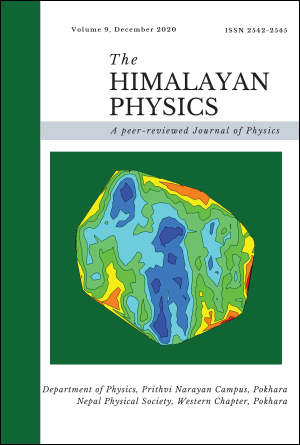Study of Dust Properties of two Far Infrared Cavities near by Asymptotic Giant Branch stars under Infrared Astronomical Satellite Maps
DOI:
https://doi.org/10.3126/hp.v9i01.40193Abstract
The physical properties such as dust color temperature, dust mass, visual extinction, and Planck function with their distribution in the core region of two far-infrared cavities, namely FIC16-37 (size ~ 4.79 pc x 3.06 pc) located at R.A. (J2000): 16h 33m 57.25s & Dec. (J2000): -37d 47m 04.3s, and FIC12-58 (size ~ 22.54 pc x 14.84 pc) located at R.A. (J2000): 12h 52m 50.08s & Dec. (J2000): -58d 08m 55.02s, found within a galactic plane -10o to +10o nearby Asymptotic Giant Branch (AGB) stars namely AGB15-38 (R.A. (J2000): 15h 37m 40.74s & Dec. (J2000): -38d 20m 24.6s), and AGB12-57 (R.A (J2000): 12h 56m 38.50s & Dec. (J2000): -57d 54m 34.70s), respectively were studied using Infrared Astronomical Satellite (IRAS) survey. The dust color temperature was found to lie in the range of 23.95 ± 0.25 K to 23.44 ± 0.27 K with an offset about 0.5 K for FIC16-37, and 24.88 ± 0.27 K to 23.63 ± 0.98 K with an offset about 1 K for FIC12-58. The low offset in the dust color temperature indicated the symmetric distribution of density and temperature. The total mass of the cavities FIC16-37 and FIC12-58 were found to be 0.053 M☉ and 0.78 M☉, respectively. The contour plots of mass distribution of both of the cavities was found to follow the cosmological principle, suggesting the homogeneous and isotropic distribution of dust masses. The plot between temperature and visual extinction showed a negative correlation, suggesting that higher temperature has lower visual extinction and vice-versa. The distribution of Planck function along major and minor diameters of both of the cavities was found to be non-uniform, indicating oscillation of dust particles to get dynamical equilibrium. It further suggested the role of pressure-driven events nearby both cavities and suggested that dust particles are not in thermal equilibrium along the diameters.
Downloads
Downloads
Published
How to Cite
Issue
Section
License
This license enables reusers to distribute, remix, adapt, and build upon the material in any medium or format for noncommercial purposes only, and only so long as attribution is given to the creator. If you remix, adapt, or build upon the material, you must license the modified material under identical terms.




